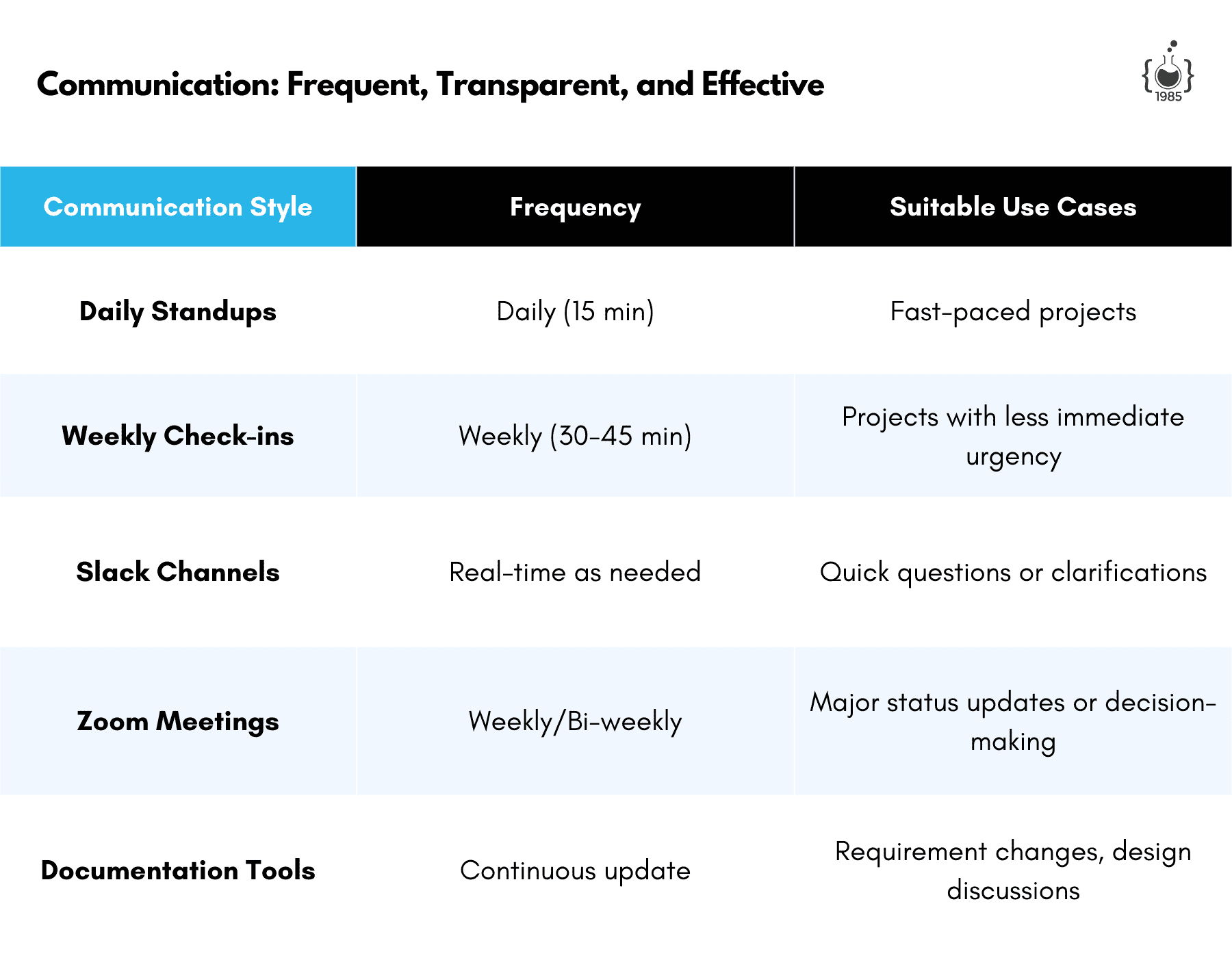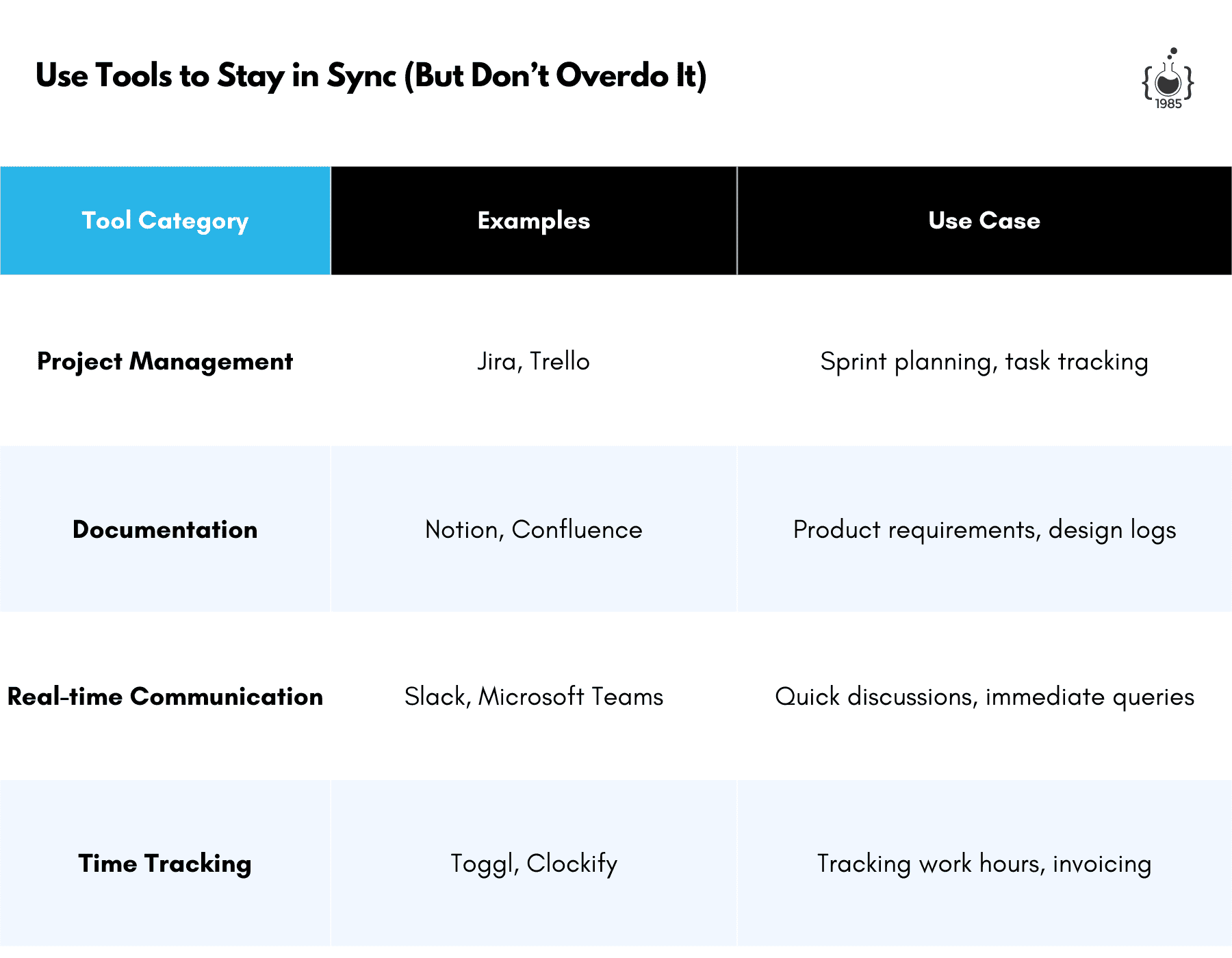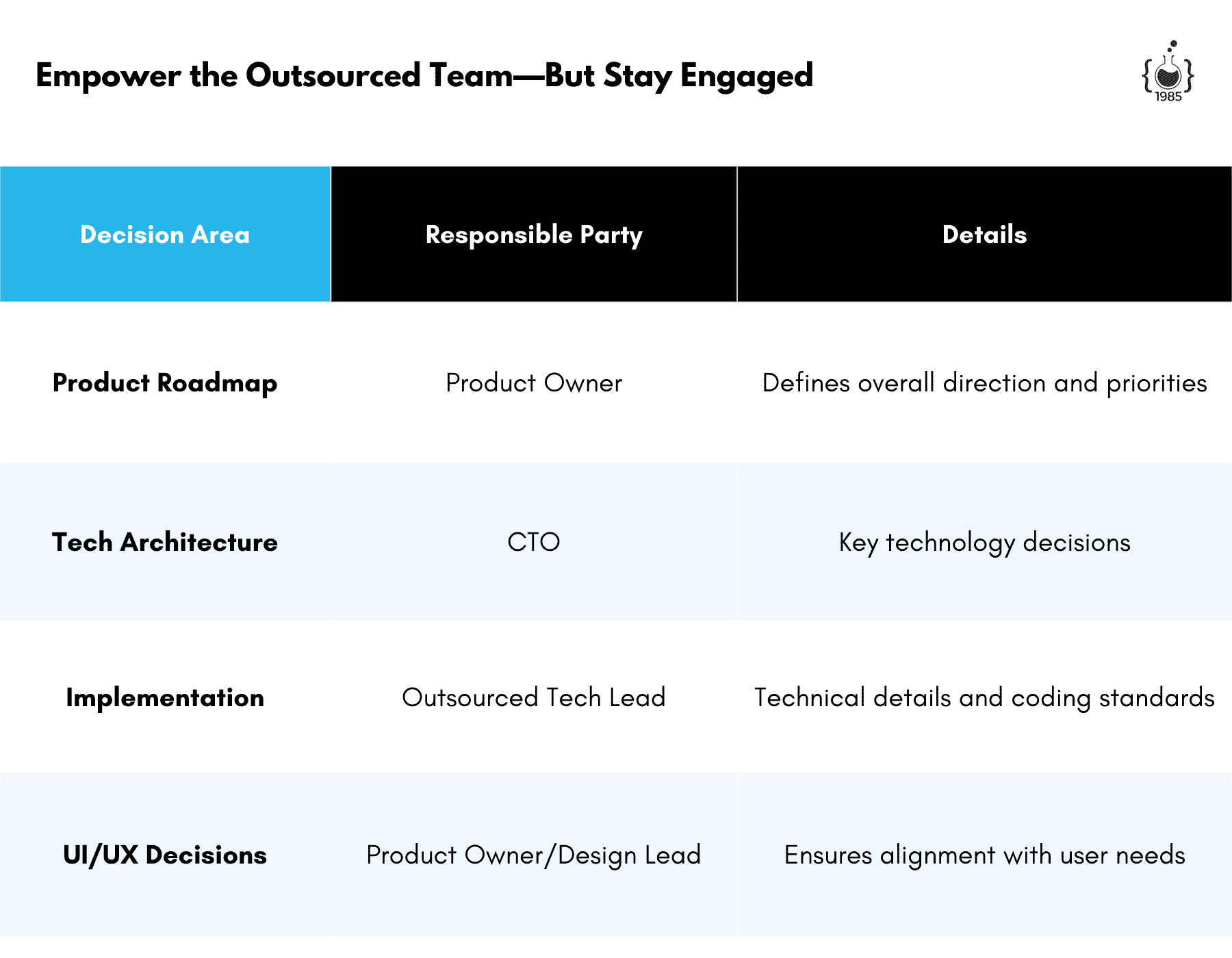How Do We Maintain Control Over the Development Process with an Outsourced Team?
Outsourcing doesn’t have to mean losing control—find out how to align your goals and keep projects on track.

If you’re working with an outsourced software development team like 1985, you probably have this question in mind: How do we stay in the driver's seat? How do we ensure we’re not just throwing our project into the void and hoping for the best? Trust me—it’s a valid worry. I’ve been in this industry for over a decade. I know the stakes and I know the horror stories: budgets blown up, timelines lost in the fog of confusion, final products so off-base they might as well have been made for a different company altogether.
When you outsource, you’re essentially extending your team—stretching that collaboration cord across cities, time zones, even continents. And there’s a thin line between extending and losing that cord. Maintaining control isn't just about putting people on a task and hoping they don’t mess it up. It’s about processes, about alignment, about making sure your expectations have a direct path to execution. And you know what? Done right, outsourced development can work wonders. You can get scalability, fresh perspectives, and the skillsets you just don’t have in-house. But that “done right” bit is the tricky part.
Let’s talk about how you can do it—in ways that are nuanced, actionable, and honestly, a bit human.
1. Establish Clear Metrics and Define Success Upfront
Imagine running a marathon without knowing where the finish line is. Sounds exhausting, right? The same goes for development projects—outsourced or otherwise. But too often, businesses start with vague goals like, “We want a fast, modern-looking app.” What’s fast? What’s modern? To stay in control, success must be as tangible as possible.

Here’s how you do it: Start by establishing specific metrics. Does “fast” mean the app loads in under two seconds for users in North America? Or does it mean there’s a snappy onboarding process? Lay it out clearly. Talk KPIs—Key Performance Indicators—with your outsourced team. You want to remove any potential gray areas right from the beginning.
These metrics might include:

Having these clear, well-defined metrics means everyone knows exactly what you’re aiming for. Your outsourced team understands what “success” looks like—no interpretation needed. The clearer the expectations, the easier it is to manage outcomes, and the better chance you have at keeping control over the entire process.

2. Communication: Frequent, Transparent, and Effective
Here’s the uncomfortable truth: Most of the problems in outsourced projects stem from poor communication. It’s the “how” and “when” of conversations that make or break the collaboration. And this is especially true when your team is miles—or oceans—away.

Daily Standups vs. Weekly Check-ins: Now, I’m not suggesting you need to micro-manage. Nobody likes the boss breathing down their neck—even virtually. But you do need to set a consistent rhythm for updates. For fast-paced projects, daily standups (yes, even just 15 minutes) can help keep everyone aligned. On less hectic timelines, weekly check-ins can suffice. The key is consistency.
Clear Communication Channels: Decide where conversations happen. Are you using Slack for quick pings? Zoom for the big weekly sync? Trello for task updates? Document it—and stick to it. Many projects go sideways simply because the team doesn’t know where to communicate, and crucial messages get lost across WhatsApp, email, and random Zoom chats. Trust me, you don’t want to spend an afternoon searching through 35 Slack threads to find a vital piece of information.
Be Transparent: If there’s an issue, bring it up immediately. Hidden problems fester, and by the time they’re visible, it’s often too late to avoid damage. This applies to both sides—if the outsourced team is facing blockers, you want them to feel comfortable enough to share right away. Foster that openness. Make sure they know that transparency is valued more than flawless execution.

3. Invest in the Discovery Phase—Don’t Skip It
The discovery phase is where everything starts. And in the rush to get to coding, many teams skip over it—big mistake. Think of the discovery phase like getting to know someone before a long road trip. You’d want to know their quirks, preferences, and limitations before spending 12 hours in a car together, right? This phase is about deeply understanding the goals, the users, and even the technology before committing a single line of code.
A well-run discovery phase should help you:
- Clarify Objectives: Make sure everyone on the team—including your outsourced partners—understands the project’s objectives in full detail.
- Identify Risks: No project is without risks. During the discovery phase, work with your outsourced team to identify potential technical hurdles, market risks, or integration challenges. When these risks are spotted early, they can be mitigated or even avoided entirely.
- Build Trust: Before the heavy lifting begins, the discovery phase lets you and your outsourced team build rapport. It’s the perfect time for both parties to establish their expertise and to show how each side thinks and operates.

4. Keep Control by Owning the Product Roadmap
Even when you’re working with an outsourced team, the roadmap should stay firmly in your hands. It’s your guiding star—a clear plan for how the product evolves over time, where resources are allocated, and when key milestones will happen.
However, that doesn’t mean the roadmap is set in stone. Agile methodologies thrive on feedback and adaptability. But you should be the one adjusting it—not the outsourced team. As the product owner, you have the ultimate authority to decide priorities.
Here’s a tip: Break down the roadmap into manageable sprints. Let’s say your MVP needs to be ready in 10 weeks. Break it down into five two-week sprints. Each sprint should have its own mini-goals, like implementing a critical feature or completing user testing for a module. This way, you maintain control incrementally, making adjustments if a sprint didn’t go as planned or if priorities shift. The key here is adaptability while keeping the bigger picture intact.

5. Culture Matters More Than You Think
Culture. Yes, even with outsourced teams, culture matters a lot more than you think. It can mean the difference between your outsourced team feeling like disjointed freelancers versus a genuine extension of your in-house crew.
Cultural Alignment: I’m not just talking about national cultures or time zone differences—though those are important too. I’m talking about work culture. If your internal team values rapid prototyping and regular iteration, but your outsourced partners are more about rigid planning, you’re going to run into friction. Discuss work styles, decision-making processes, and even smaller preferences like how to provide feedback. These “soft” alignments can make the “hard” aspects of your project (deadlines, code quality, etc.) go a lot more smoothly.
Involve Them in Celebrations: Did you hit a big milestone? Celebrate it, and make sure your outsourced team knows. Even a simple shout-out in a Slack channel or a small team celebration call can go a long way. These little moments build rapport and make your outsourced developers feel like they’re genuinely a part of something—not just cogs in the machine.
6. Don’t Just Focus on Delivery—Quality Assurance is Key
A lot of businesses make the mistake of focusing almost entirely on delivery. They’re all about timelines and milestones—until they hit the wall of QA and find a mess waiting for them. Don’t let this happen.

Quality Assurance needs to be baked into every phase of the project—not tacked on as an afterthought. Work with your outsourced team to establish quality benchmarks early on. Set up a robust testing process that includes:
- Automated Testing: Catch issues early with automated unit tests.
- Manual Testing: Involve real users (or stakeholders) during manual testing phases to spot usability issues.
- Regression Testing: Make sure new features aren’t breaking old ones.
The earlier bugs are caught, the easier—and cheaper—they are to fix. By emphasizing quality assurance throughout the process, you maintain control over the end product’s reliability, user experience, and ultimately—its success.

7. Use Tools to Stay in Sync (But Don’t Overdo It)
We’re living in a golden age of project management tools—Trello, Jira, Asana, Notion, ClickUp… you name it. These tools can be lifesavers for staying in control, but the trick is to use them effectively without getting overwhelmed.

- Project Tracking: Choose a tool like Jira for sprint planning and ticket management. Make sure your outsourced team is updating their progress here so that everything is visible to you.
- Documentation: Use a collaborative tool like Notion or Confluence for documentation. Your product requirements, design discussions, and decisions should all live in a place accessible to everyone.
- Communication: Slack is great for real-time communication, but ensure it’s used for discussions that don’t require in-depth context—those should be reserved for email or a project management system.
The goal here is balance. You want visibility—but not micromanagement. Provide your team with the tools, set the standards, and then trust them to keep it up. Excessive oversight can damage morale and create bottlenecks.

8. Empower the Outsourced Team—But Stay Engaged
The irony of maintaining control is that you often have to give some of it away. Empower your outsourced developers to make certain decisions—especially ones that are purely technical. If every small decision has to go through multiple layers of approval, you’re going to find yourself stuck in bottleneck city.

Clear Decision Rights: Define who has decision-making rights for what. Maybe your CTO has the final word on architectural decisions, but your outsourced tech lead can decide on implementation details. The idea here is to draw boundaries that empower the outsourced team while keeping you, the product owner, in the loop on bigger decisions.
Staying engaged is equally critical. Attend sprint retrospectives, review code (if you’re technical), and get involved in user testing phases. The goal is to maintain presence without creating friction.

9. Manage the Human Element—Not Just the Technical Side
The thing about outsourcing is, at its core, it’s still a human endeavor. We’re not working with lines of code—we’re working with people. A team that’s motivated, aligned, and engaged will deliver results that far outstrip a team that feels isolated, undervalued, or micromanaged.
- Check-in on Well-being: You’re working with people—and sometimes that means a simple “Hey, how’s everything going?” on a call can make a difference.
- Trust Your Team: Outsourced or not, trust needs to be the foundation. If you hired them, you should trust them. Give them autonomy, provide clarity on objectives, and avoid the urge to control every step. People do their best work when they feel trusted.
- Listen Actively: When the outsourced team has suggestions, listen. Often, they bring an external perspective that can illuminate blind spots. Keeping an open mind ensures that you’re in control not just through authority, but through collaboration.
Control Through Trust and Alignment
Maintaining control over an outsourced development process isn’t about having your hand on every piece of code. It’s about aligning objectives, fostering communication, and building trust. It’s about having clear metrics, owning the roadmap, but empowering your team to execute in their own best way.
At the end of the day, the goal is to make the outsourced team an extension of your own. Not a separate entity. And that means recognizing that control isn’t just about authority—it’s about clarity, alignment, trust, and culture.
Get those right, and you’ll be amazed at what a well-managed outsourced development team can achieve.



